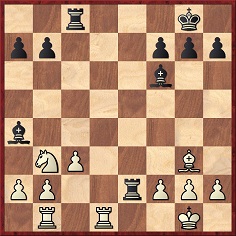Chess Notes
Edward Winter
When contacting us by e-mail, correspondents are asked to include their name and full postal address and, when providing information, to quote exact book and magazine sources. The word ‘chess’ needs to appear in the subject-line or in the message itself.
| First column | << previous | Archives [160] | next >> | Current column |
10632. Nicolas Rossolimo and judo
Hans Renette (Bierbeek, Belgium) sends this picture from page 2 of De Gooi- en Eemlander, 31 July 1947:
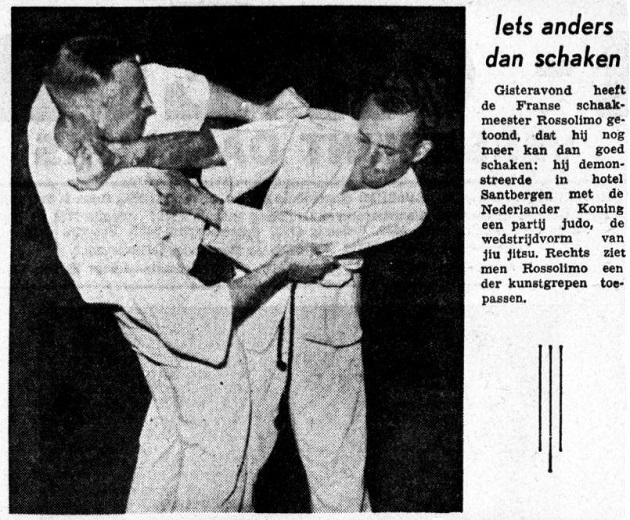
10633. Ray Charles
Paul Dorion (Montreal, Canada) notes on a CNN webpage a fine photograph of Ray Charles (1930-2004) with a Braille chess set.
10634. Fischer and Lombardy
In October 2017 Michael Clapham’s website Chess Book Chats (mentioned in C.N. 10089) had excellent items on Bobby Fischer and William Lombardy.
10635. A rusty nail
The present item may be read in conjunction with A Knight on K5, K6 or Q6.
A question asked by Jerry Hanken on page 15 of Chess Life, September 2005:
‘Was it Tarrasch who said a knight on d6 is like a rusty nail in the knee?’
A number of bottom-of-the-range Internet pages sourcelessly ascribe such a remark to Bogoljubow, the square occupied being given as e6/e3.
On page 58 of Chess Strategy and Tactics by Fred Reinfeld and Irving Chernev (New York, 1933) the observation appeared in quotation marks, but unattributed, in the game Bogoljubow v Réti, Mährisch-Ostrau, 1923:
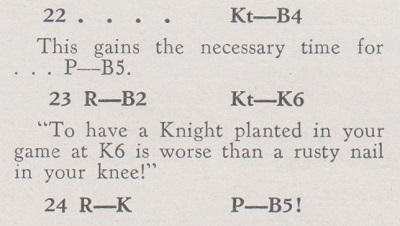
Elsewhere, Anderssen and Steinitz have been named. Below, for example, is a footnote on page 112 of Chess Traps, Pitfalls, and Swindles by I.A. Horowitz and Fred Reinfeld (New York, 1954), concerning White’s move Nd6:
‘Of such powerfully posted knights the immortal Anderssen remarked, “They are like a rusty nail in your knee!”’
From page 93 of Bishop versus Knight: The Verdict by Steve Mayer (Seattle, 1997):
‘There’s an old line, generally attributed to Steinitz, that a knight at e6 is like a rusty nail in the knee.’
Another variant comes from page 87 of Reinfeld’s Great Short Games of the Chess Masters (New York, 1961), after 10 Nc6:
‘Of such knights, posted deep in the enemy’s territory, it has been truly said that they are “like a rusty nail in your knee”.’
Who can say whether Anderssen, Steinitz, Tarrasch, Bogoljubow or somebody else made such a remark about a knight on Q6, K6, QB6 or KB6 – or, indeed, whether the nail-like occupant was necessarily a knight? The annotation below is by Jack W. Collins on page 19 of the November 1947 Chess Review:
‘He has two bishops, a passed pawn at K6 (a rusty nail in the knee, according to Steinitz), and aggressively placed rooks.’
10636. An inscription by Smyslov
‘“To the world champion of Chess Literature” – such was the flattering manner in which Smyslov inscribed the book of his collected games which he presented to Harry Golombek on the day he won the world championship from Botvinnik.’
Source: page 170 of The Delights of Chess by Assiac (London, 1960). For a more specific, and less flattering, assessment, see Harry Golombek’s Book on Capablanca.
One of our copies of the 1974 Dover reprint of The Delights of Chess has a full-page signature by Tony Miles:
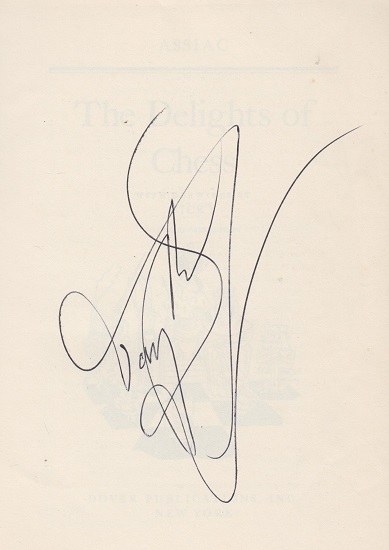
10637. Louis Persinger
A feature article on Louis Persinger is in preparation, based on a number of C.N. items on his involvement in chess. Richard Reich (Fitchburg, WI, USA) reports that he owns a copy of Capablanca’s Havana, 1913 tournament book signed by Persinger:
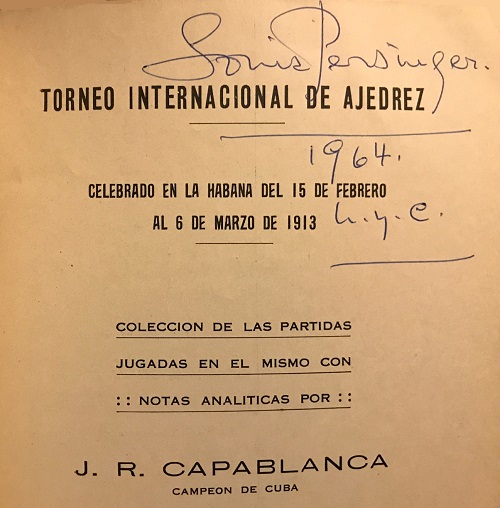
10638. Ernest Hemingway
Richard Reich asks whether any solid biographical information is available about Ernest Hemingway’s interest in chess.
10639. 16 computations a second
Further to C.N. 2646 (see Chess and Computers), the device in question was discussed on page 34 of Chess Review, February 1953, where Robert H. Dunn quoted the following:

10640. L. Verkhovsky
Siegrun Macgilchrist (Maybole, Scotland) asks for biographical information on Leonid Verkhovsky. Can readers suggest any particularly good sources?
Verkhovsky is best known for his 1972 book Nichya!; a Spanish translation, Tablas, was published the following year. A second Russian-language edition appeared in 1979; regarding the shoddy English version (Milford, 2014) see C.N. 9098.
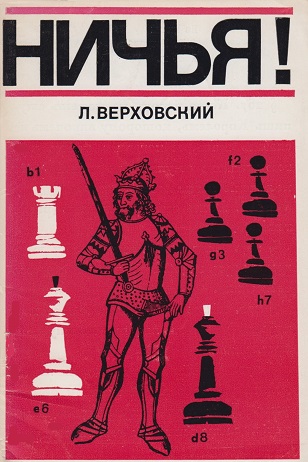
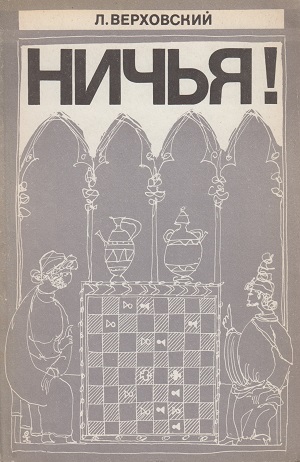
Verkhovsky also wrote a book on Zugzwang (Moscow, 1989), and an Italian translation came out in 1992. Another work is a monograph on Schlechter (Moscow, 1984), with a Foreword by Lev Polugayevsky.
10641. Steinitz and Chigorin
How much of Fred Reinfeld’s passage below, concerning Steinitz and Chigorin, can be corroborated?

The source is Reinfeld’s book The Great Chess Masters and Their Games (subtitle: ‘The Human Side of Chess’). See pages 109-110 of the original US edition (New York, 1952) and page 113 of the UK edition (London, 1953).
10642. Capablanca games
Gerard Killoran (Ilkley, England) sends a game from page 2 of the Sunday Oregonian, 6 August 1916:
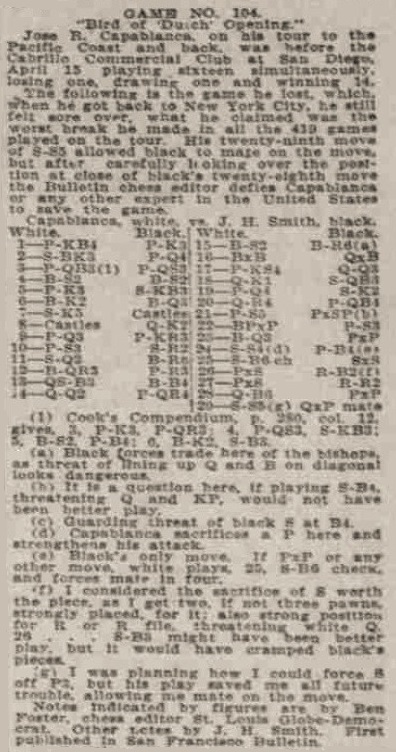
José Raúl Capablanca (simultaneous) – J.H. Smith
San Diego, 15 April 1916
Bird’s Opening
1 f4 e6 2 Nf3 d5 3 b3 b6 4 Bb2 Bb7 5 e3 Nf6 6 Be2 Bd6 7 Ne5 O-O 8 O-O Qe7 9 d3 h6 10 g3 Nh7 11 Nd2 Ba3 12 Bc3 a6 13 Ndf3 Bc5 14 Qd2 a5 15 Bb2 Ba3 16 Bxa3 Qxa3 17 g4 Qd6 18 Qe1 Nc6 19 d4 Ne7 20 Qh4 c5
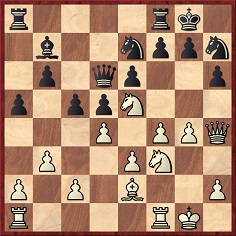
21 g5 hxg5 22 fxg5 g6 23 Bd3 cxd4 24 Ng4 f5 25 Nf6+ Nxf6 26 gxf6
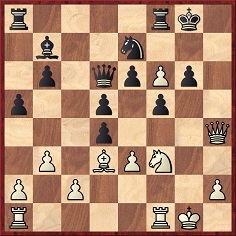
26...Rf7 27 fxe7 Rh7 28 Qf6 dxe3 29 Ng5 Qxh2 mate.
Our correspondent also reports that page 6 of the 16 November 1919 edition of the same newspaper had this game (bare score):
José Raúl Capablanca (simultaneous) – Charles F.
Bauder
Philadelphia, 28 September 1918
Queen’s Gambit Declined
1 d4 d5 2 Nf3 Nf6 3 c4 e6 4 Nc3 c6 5 Bg5 Nbd7 6 e3 Qa5 7 Nd2 Bb4 8 Qc2 Ne4 9 Ndxe4 dxe4 10 Bh4 e5 11 Be2 O-O 12 O-O

12...f5 13 c5 Nf6 14 dxe5 Bxc3 15 bxc3 Nd5 16 c4 Qxc5 17 Qb2 Qb4 18 Qxb4 Nxb4 19 Be7 Na6 20 Bxf8 Kxf8 21 f4 Nb4 22 Rfc1 c5 23 a3 Nc6 24 Rd1 Be6 25 Rd6 Ke7 26 Rb1 Na5 27 Rbd1 b6 28 h3 g6 29 Kh2 Rb8 30 g4 Rb7
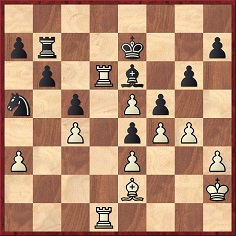
31 Rxe6+ Kxe6 32 gxf5+ gxf5 33 Rd6+ Ke7 34 Rh6 Kf8 35 Rh5 Rf7 36 e6 Rf6 37 Rxh7 Rxe6 38 Rxa7 Rh6 39 Bf1 Rd6 40 h4 Rd2+ 41 Kg3 Ra2 42 h5 Rxa3 43 h6 Rxe3+ 44 Kh4 Kg8 45 Bh3 Rxh3+ 46 Kxh3 Nxc4 47 Kh4 Nd6 48 Kg5 Nf7+ 49 Kg6 Nh8+ 50 Kf6 Nf7 51 Rxf7 Resigns.
10643. L. Verkhovsky (C.N. 10640)
Vitaliy Yurchenko (Uhta, Russian Federation) notes the information about Verkhovsky on the back cover of a 2005 book by him:

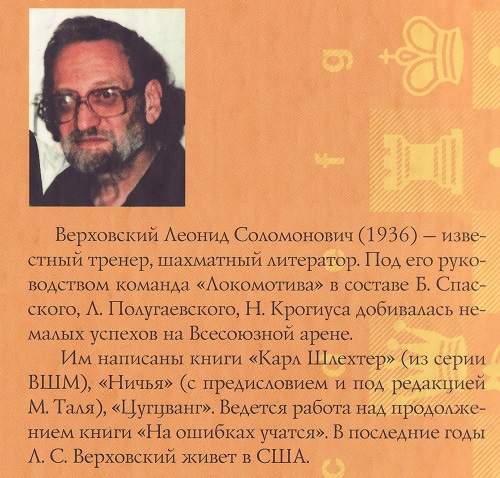
Dan Scoones (Port Coquitlam, BC, Canada) draws attention to a webpage about Evgeny Gik with references to Verkhovsky having died and another Russian page featuring a photograph of Verkhovsky with Vladimir Lepeshkin.
10644. The BCM (C.N.s 10538, 10579 & 10613)
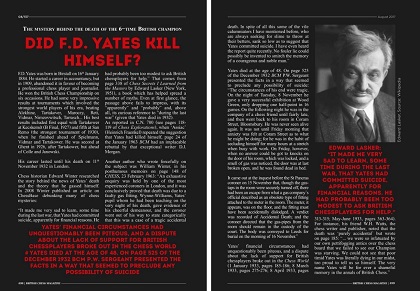
Below is a letter which we sent on 17 October 2017 by e-mail and registered post to the Editor of the BCM, with a copy to Mr Milan Dinic:
For publication, please
Dear Sirs,
The “clarification” on page 614 of the October 2017 BCM refers misleadingly to my e-mail reply of 29 September to Mr Dinic. As shown by my full text (C.N. 10613 at chesshistory.com), the unsigned F.D. Yates article on pages 498-499 of the August 2017 BCM reproduced, word for word and without permission, an entire ChessBase feature of mine (about 700 words). No fewer than 93 lines of the two-page BCM article were written by me, i.e. about 80% of the whole BCM text.
My e-mail message nominated a charity to which I asked the BCM to make a substantial donation for misappropriating my work.
Yours faithfully,
Edward Winter
No reply, whether public or private, having been received, we simply summarize the facts (as shown in detail in C.N.s 10538, 10579 and 10613):
- In the article about Yates in the August 2017 BCM the general introductory paragraph was lifted from Wikipedia, the other text was a copy-paste of our work, and the illustrative photograph supposedly of “Edward Lasker” was Emanuel Lasker.
- The September 2017 BCM had a ‘correction’, but only concerning the Lasker photograph blunder. Moreover, the ‘correction’ was itself incorrect, stating that the author of the article was Pete Tamburro (who had no involvement in it).
- On 28 September 2017 Mr Milan Dinic of the BCM sent us an e-mail message (nearly 600 words) which blamed faulty typesetting (the misuse of quotation marks) in the August 2017 article.
- Our response the following day stressed how much of our work the BCM had lifted without permission, and we therefore asked the magazine to make a donation to charity.
- No reply was received, but the October 2017 BCM published a ‘clarification’ which offered no clarity at all, contradicted Mr Dinic’s message to us and misrepresented our message to him.
- Our letter of 17 October 2017 having been ignored, the BCM is still concealing from its readers its gross misappropriation of our work. The magazine’s own contribution to the two-page spread on Yates was virtually zero.
10645. Pillsbury blindfold game
Eduardo Bauzá Mercére (New York, NY, USA) sends this game from a 12-board blindfold display:
Harry Nelson Pillsbury – Edward Douglas Fawcett
Exeter, 24 April 1902
Ruy López
1 e4 e5 2 Nf3 Nc6 3 Bb5 Nf6 4 O-O Nxe4 5 d4 Be7 6 Qe2 Nd6 7 Bxc6 bxc6 8 dxe5 Nb7 9 Nc3 O-O 10 Re1 Re8 11 Qc4 Nc5 12 Ng5 Bxg5 13 Bxg5 Qxg5 14 Qxc5 Bb7 15 Qb4 Rab8 16 f4 Qg6 17 Qe4 Qxe4 18 Nxe4 Re7 19 Nc5 d5 20 exd6 Rxe1+ 21 Rxe1 Resigns.

Source: Western Times, 25 April 1902, page 12.
We add a photograph of E. Douglas Fawcett from page 464 of The Tatler, 5 September 1934:
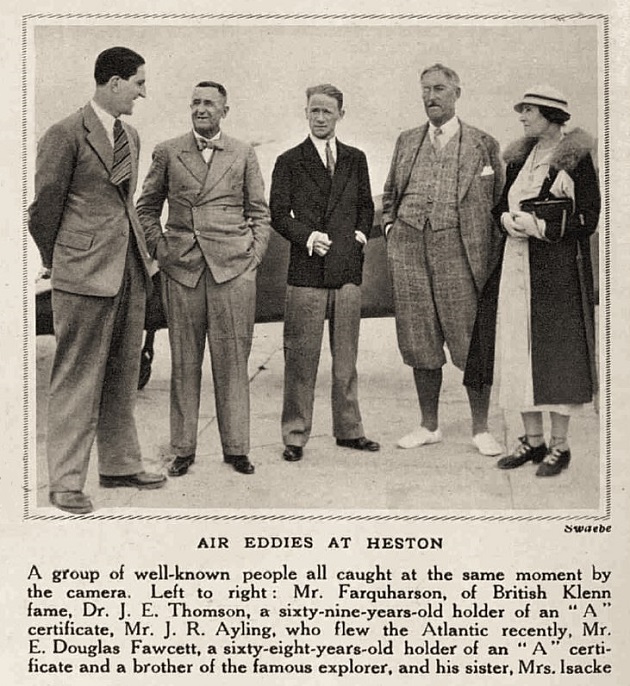
10646. Steinitz and Chigorin (C.N. 10641)
Dan Scoones (Port Coquitlam, BC, Canada) writes:
‘The final quote from Chigorin in C.N. 10641 was on page 13 of Nikolai Grekov’s book Soviet Chess (New York, 1949):
The book’s translator was Theodore Reich.
Earlier the Chigorin quote had been given by Grekov on page 539 of his book Великий русский шахматист М. И. Чигорин (Moscow, 1939), again without any source:
“Нередко... ‘теоретическое’ – синоним шаблонного. Ибо что такое ‘теоретическое’ в шахматах, как не то, что можно встретить в учебниках и чего стараются придерживаться, раз не могут придумать чего-либо более сильного или равного, самобытного.”
I propose this translation:
“Often ... the ‘theoretical’ is synonymous with the stereotypical. For the ‘theoretical’ in chess is nothing other than what can be found in textbooks, which people try to follow because they cannot think of anything stronger, equally strong, or original.”’
10647. L. Verkhovsky (C.N.s 10640 & 10643)
Another book by Leonid Verkhovsky (joint authorship with Yuri Averbakh) is pointed out by Vitaliy Yurchenko (Uhta, Russian Federation):
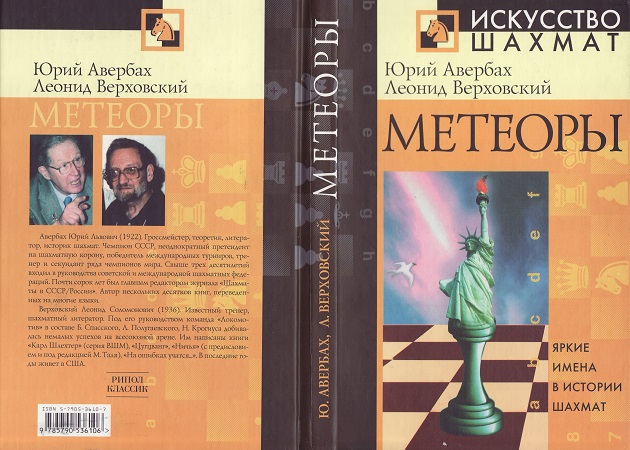

It is again stated that Verkhovsky was resident in the United States and that he was born in 1936. However, our correspondent notes that according to page 55 of Шахматная еврейская энциклопедия by Igor Berdichevsky (Moscow, 2016) Verkhovsky was born in Moscow on 26 December 1938.
10648. Capablanca in Buenos Aires
Eduardo Bauzá Mercére (New York, NY, USA) sends two photographs (references: AR_AGN_DDF/Consulta_INV: 126775 and AR_AGN_DDF/Consulta_INV: 126774) from Argentina’s Archivo General de la Nación, courtesy of the Ministerio del Interior, Obras Públicas y Vivienda. They show simultaneous exhibitions by Capablanca in Buenos Aires on 7 May 1911 (30 boards) and 29 June 1911 (40 boards).
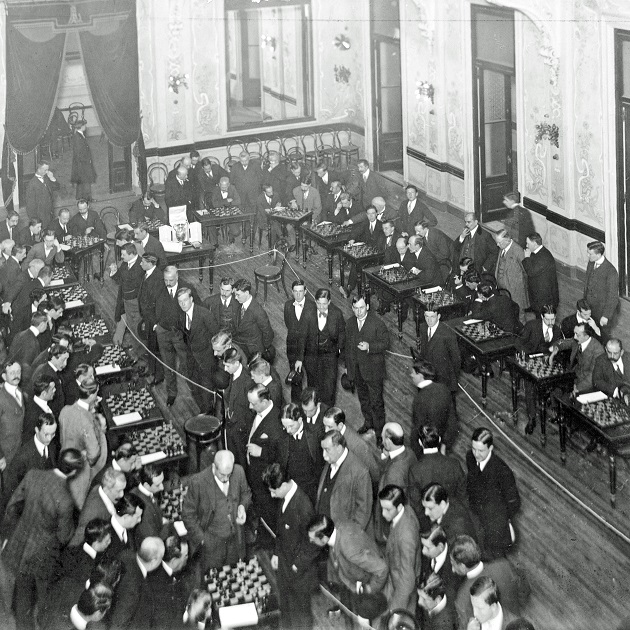
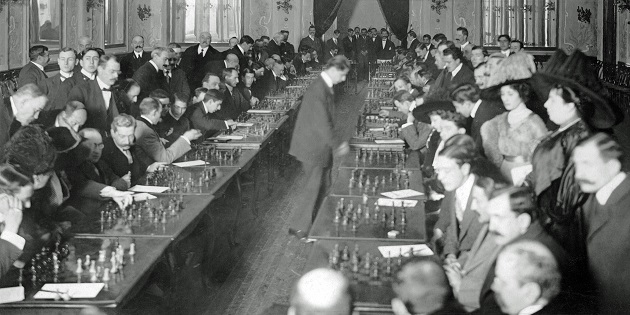
10649. Napoleonic drawing

This picture is owned by Ross Jackson (Raumati South, New Zealand), who writes:
‘The drawing was advertised for sale as follows:
“Tuschzeichnung über Bleistift. Zwei Offiziere beim Schachspiel, ein dritter zuschauend. Wohl Berlin (‘Unterbaum’), den 28. May 1807. Circa 15,4 x 18,8 cm. 1 Blatt verso Andeutungen von Bleistiftskizzen.”
The seller informed me that he obtained it from a German collector of nineteenth-century art. The inscription “Unterbaum, den 28. May 1807” suggests Berlin during the French occupation. Danzig surrendered on 24 May 1807.’
10650. Small books on Fischer’s games (C.N. 10622)
Richard Reich (Fitchburg, WI, USA) notes that other little books (not involving Fischer) in Michael Basman’s ‘Turnover Chess’ series were shown in an entry dated 13 January 2016 at the Chess Book Chats website of Michael Clapham.
10651. Walter Slezak (1902-83)
From the front cover of Chess Review, July 1953:
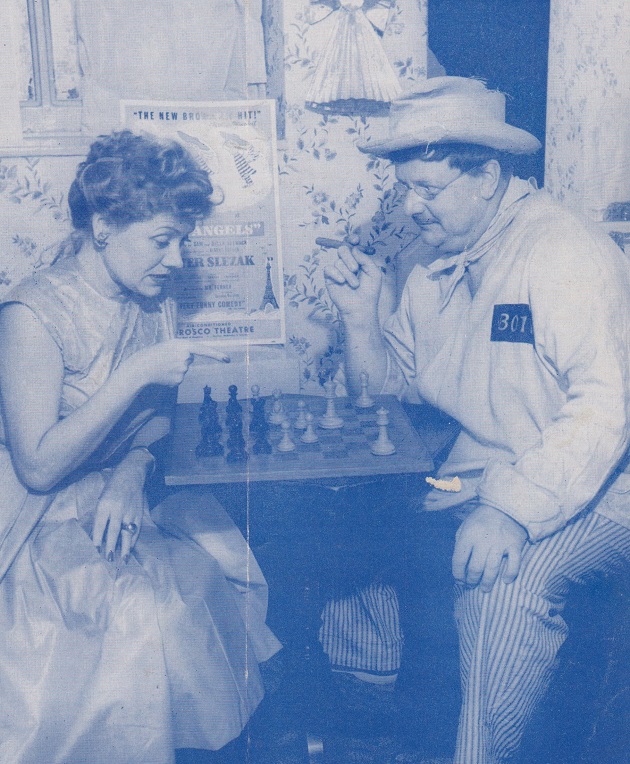
Page 195 had this information:
‘Walter Slezak, the star of My Three Angels, plays at chess with his wife, Johanna, in an interim backstage at the Morosco Theatre.’
10652. Capablanca v Horner
From John Donaldson (Berkeley, CA, USA):
‘I have found the following game in the papers of the late John W. Collins located in Lily Library at Indiana University:
José Raúl Capablanca (simultaneous) – Roland Horner
Philadelphia (early 1920s)
Ruy López1 e4 e5 2 Nf3 Nc6 3 Bb5 Nge7 4 d4 exd4 5 Nxd4 d5 6 exd5 Qxd5 7 O-O Bd7 8 Bxc6 Nxc6 9 Re1+ Be7 10 Nxc6 Qxd1 11 Rxd1 Bxc6 12 Bf4 O-O 13 Bxc7 Bf6 14 c3 Rfe8 15 Nd2 Rac8 16 Bg3 Ba4 17 Nb3 Re2 18 Rab1
18...Rce8 19 h3 h5 20 Rd2 h4 21 Bf4 b6 22 Rxe2 Rxe2 23 Nd2 Bc2 24 Rc1 Bd3 25 Be3 Kh7 26 a4 a6 27 Rd1 b5 28 axb5 axb5 29 Nf3 Be4 30 Rd2 Rxd2 31 Nxd2 Bd3 32 Bd4. The game was adjudicated a win by Capablanca.
Source: a letter from Horner to John Collins dated 15 November 1970. The game was played at the Franklin Chess Club in the early 1920s. Schuyler Jackson, a friend of Horner, played alongside him.
Hooper and Brandreth’s table in The Unknown Capablanca has simultaneous displays in Philadelphia on 25 February 1922, 18 November 1922, 8 March 1924 and 11 October 1924, but no further details about the Horner game have been traced so far.’
10653. A common question
‘Are you playing for a win?’ is a common question, and a Google Books search (without, even, the need to specify ‘chess’) provides a number of examples of the replies offered.
Another one, ‘If you let me’, was reported by Wolfgang Heidenfeld on page 25 of Chess Springbok (Cape Town, 1955) concerning the position at move 43 in his game as White against Donner at Cheltenham, 1953:
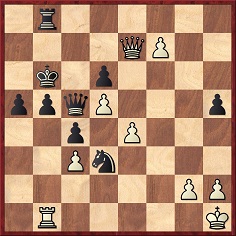
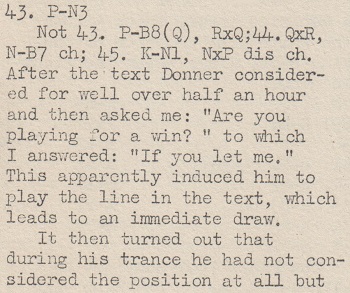

10654. Heidenfeld and Kreymborg
A further quote from Wolfgang Heidenfeld’s 1955 book Chess Springbok (page 27):
‘Of all the countries I have visited outside the Iron Curtain, Holland is by far the most chess-conscious. Players of all classes and standards take their chess seriously and are always ready for more. A visiting chess master will find no difficulty in either having a small weekend tournament arranged for him, in the course of which he may meet three or four Dutch masters, or encountering individual opponents of master strength in match games.’
After recalling major chess events held in the Netherlands over the previous two decades, Heidenfeld wrote:
‘How puny in comparison is the record of Great Britain, not to mention such countries as Belgium and France where Cinderella, not Caissa, is the patron saint of chess.’
The reference to Caissa as the patron saint of chess, as opposed to the goddess, brings to mind a poem by Alfred Kreymborg, ‘Chess Players’, on pages 120-124 of Blood of Things (New York, 1920). It began:
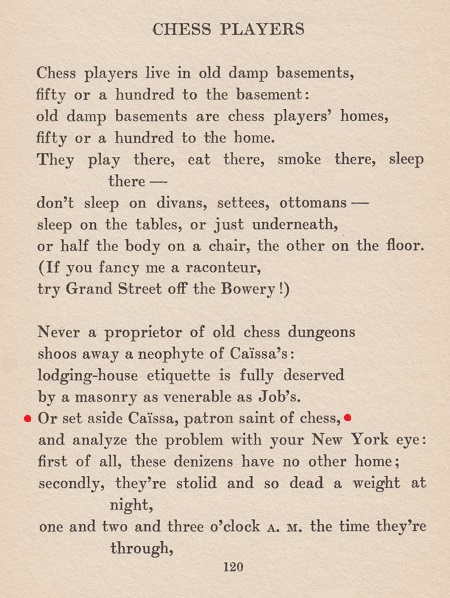
Our signed copy of the book has a small brochure with these pictures:
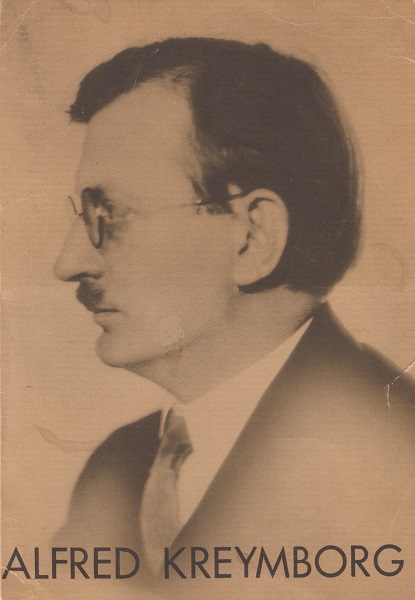

Concerning the patron saint of chess, see C.N. 2215 (page 142 of A Chess Omnibus) and C.N. 9071.
10655. Marshall in New Orleans
John Hilbert (Amherst, NY, USA) sends a photograph from the New Orleans Times-Democrat, 16 March 1913, part 2, page 10:

Our correspondent notes that page 102 of the May 1913 American Chess Bulletin mentioned the photograph in its account of Marshall’s visit to New Orleans.
10656. James A. Leonard
Regarding James A. Leonard, below is another contribution from John Hilbert:
‘Just recently Joost van Winsen brought it to my attention that a photograph of Leonard now appears in the digital collection of the Cleveland Public Library.
On page 187 of my 2006 book on Leonard I wrote:
“That same day [12 April 1862], Hazeltine published a brief thank you in his Clipper column to the Morphy Chess Rooms’ Klatzl: ‘Received with most hearty thanks; a photograph of our friend Leonard is something to brag of, and goes among the choicest of our chess treasures.’ Photographs of Leonard were difficult to obtain even at the time. Hazeltine would later write, in 1867, that ‘We know not that more than one likeness of the departed was ever taken. The Appletons had him on their list of cartes de visite: but a friend, we understand, soon bought them all up, and they are now extremely rare.’ Ironically, then, one friend’s love of Leonard, in wishing to remember him, has made it harder for posterity to do the same. No photograph of Leonard has ever been found. The one, poor line engraving of him appearing in this volume, taken from Brentano’s Chess Monthly, is all that remains.”’
With the permission of the Cleveland Public Library we reproduce the photograph:
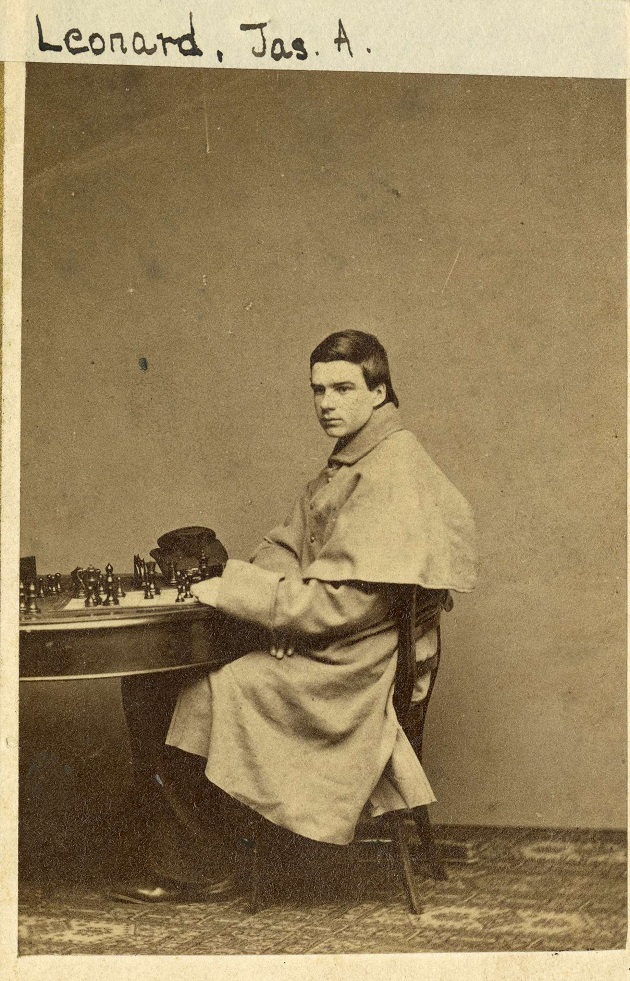
| First column | << previous | Archives [160] | next >> | Current column |
Copyright: Edward Winter. All rights reserved.


